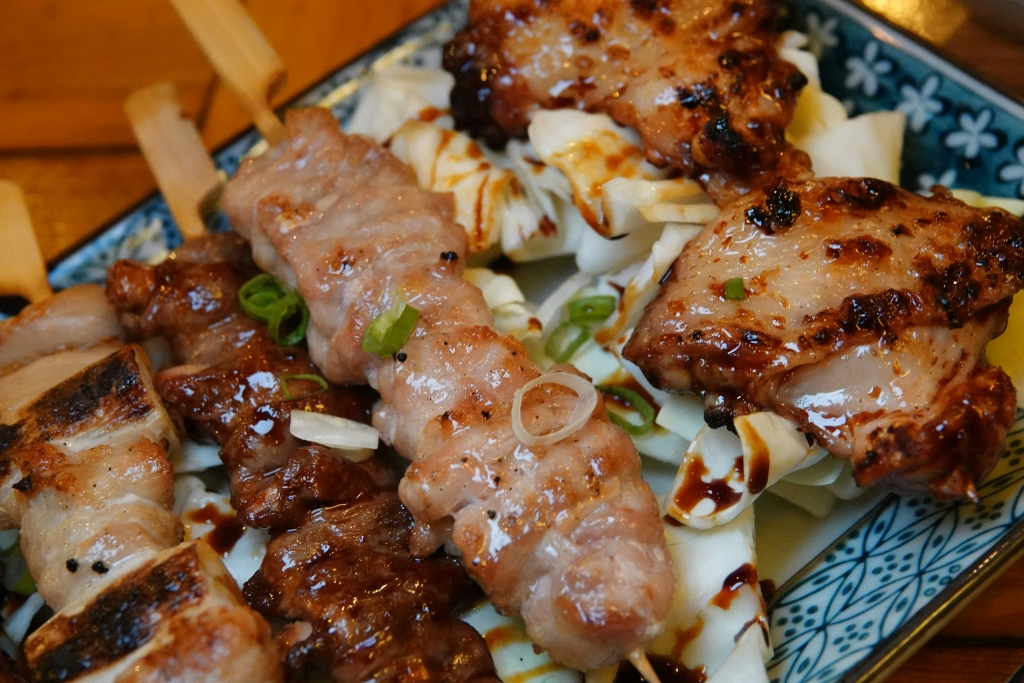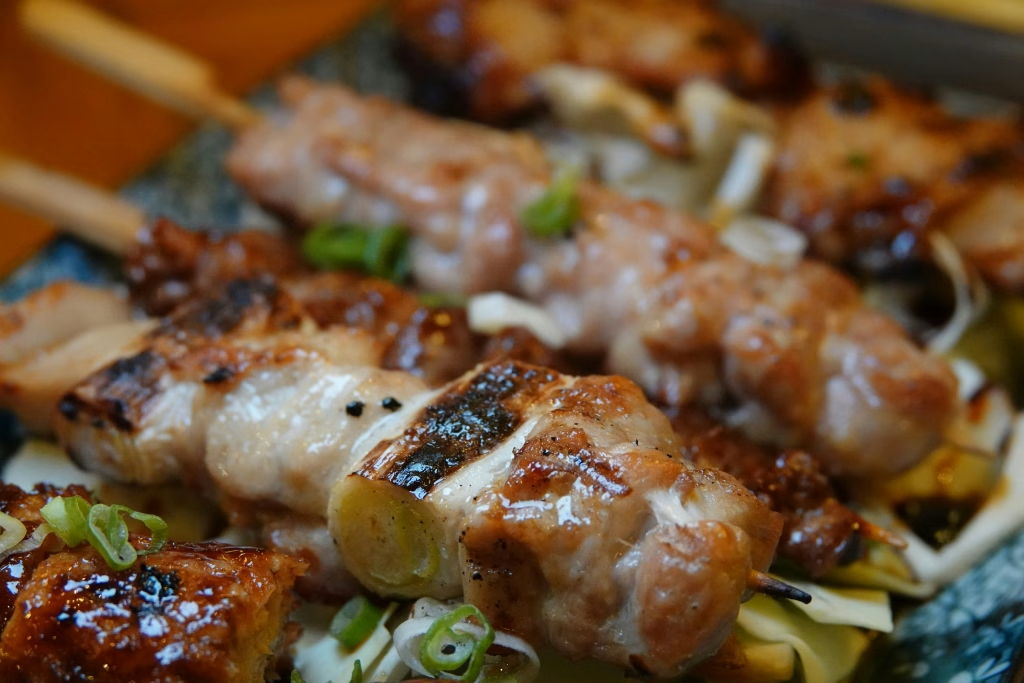Japanese Yakitori is a culinary art form that transforms humble chicken skewers into flavorful bites of grilled perfection. Served from bustling izakayas (Japanese pubs) to gourmet restaurants and even convenience stores across Japan, yakitori is more than just street food, it’s an experience.
These skewered, charcoal-grilled chicken pieces are marinated or basted in savory-sweet tare sauce or simply seasoned with salt (shio), offering a delightful contrast of textures and flavors in every bite. In this detailed guide, we’ll walk you through how to make authentic Japanese Yakitori at home, from traditional ingredients to expert tips, creative twists, historical roots, and FAQs.
Table of Contents
Ingredients
For the Chicken Skewers:
- 500g (1.1 lbs) boneless chicken thighs or breast
- ½ teaspoon salt
- 10–12 bamboo or metal skewers (6-inch)
- Optional: spring onions (negi), shishito peppers, mushrooms, or bell peppers
For the Tare Sauce:
- ½ cup soy sauce
- ¼ cup mirin (sweet rice wine)
- ¼ cup sake
- 2 tablespoons sugar (white or brown)
- 1 garlic clove, minced (optional)
- 1 small knob of ginger, sliced (optional)
Garnishes (Optional):
- Shichimi togarashi (Japanese chili blend)
- Chopped scallions
- Sesame seeds
- Lemon wedges
Serves
This recipe serves 2–3 people as a main dish, or 4–5 as an appetizer.
Step-by-Step Instructions
Step 1: Prepare the Skewers
- If using bamboo skewers, soak them in water for 30 minutes to prevent burning.
- Cut chicken into bite-sized pieces (about 1 to 1.5 inches).
- Alternate chicken and optional vegetables on skewers.
Step 2: Make the Tare Sauce
- Combine soy sauce, mirin, sake, and sugar in a saucepan.
- Add garlic and ginger if using.
- Simmer over low-medium heat until the sauce thickens slightly (10–15 minutes).
- Strain and set aside. Reserve half for brushing, and half for serving.
Step 3: Grill the Yakitori
Grilling Methods:
- Charcoal grill (traditional): gives authentic smoky flavor.
- Gas grill, grill pan, or broiler: works well for indoor cooking.
- Preheat the grill to medium-high heat.
- Lightly oil the grates or pan.
- Place skewers on the grill and cook for 2–3 minutes per side.
- Begin basting with tare sauce after the first flip, continuing to turn and brush until caramelized and lightly charred.
- Total cooking time is around 8–10 minutes.
Step 4: Serve
- Serve immediately with a side of rice or beer.
- Garnish with sesame seeds, scallions, or togarashi.

Serving Suggestions
- Serve as a main with steamed rice, miso soup, and pickled vegetables.
- Include in a bento box with tamagoyaki (Japanese omelet) and greens.
- Pair with sake or beer for a true izakaya-style experience.
- Offer a yakitori platter with a variety of meats and veggies: mushrooms, beef, quail eggs, even tofu.
Tips for Perfect Yakitori
- Use boneless chicken thighs for juicier texture and more flavor.
- Don’t crowd the skewers, leave slight space between pieces for even cooking.
- Double baste: brush with tare multiple times for deep umami glaze.
- Flip frequently to avoid burning and to build up the sauce layer gradually.
- Add some charcoal chips (like binchotan) for authentic smokiness.
Healthier Alternatives
- Use chicken breast for a leaner version.
- Grill with just salt and a light squeeze of lemon instead of tare.
- Add more vegetables like bell peppers, zucchini, or onions for balance.
- Swap chicken for firm tofu or mushrooms for a vegetarian option.
- Make a low-sodium tare using reduced-salt soy sauce and less sugar.
Creative Variations
- Negima Yakitori: Classic skewers alternating chicken with scallions.
- Tsukune: Chicken meatball yakitori, often brushed generously with tare.
- Bacon-Wrapped Yakitori: Wrap chicken or veggies in thin bacon strips.
- Spicy Miso Glaze: Add miso paste and chili oil to tare for a bolder twist.
- Cheese Yakitori: A popular fusion trend, grill with a melted cheese topping.
Common Mistakes to Avoid
- Using the wrong cut of chicken: Thighs give the best texture; breasts can dry out quickly.
- Overcrowding the grill or pan: Leads to steaming, not grilling.
- Skipping the basting: Tare adds moisture, flavor, and signature color.
- Only seasoning after cooking: Salt or tare should be applied during grilling.
- High heat throughout: Use medium-high and flip regularly to avoid burning.
History of Japanese Yakitori
Yakitori, meaning “grilled bird,” dates back to Japan’s Edo period (1603–1868), though it wasn’t until the post-World War II era that it became widely popular. At that time, urban workers sought out inexpensive, fast food that could be paired with drinks in the growing number of izakayas and street stalls across cities like Tokyo and Osaka.

Traditionally, yakitori was a celebration of the entire chicken. Skilled chefs would offer skewers from all parts of the bird: liver (reba), gizzard (sunagimo), skin (kawa), and heart (hatsu), not just breast or thigh. This practice stemmed from the Japanese philosophy of minimizing waste and appreciating every part of the animal.
Over time, yakitori evolved from street food into a respected culinary specialty. Today, yakitori-ya (dedicated yakitori restaurants) carefully select ingredients and use specific charcoal types, sauces, and cutting techniques. Whether enjoyed at a festival stall or a Michelin-starred eatery, Japanese Yakitori has become an enduring symbol of casual yet refined dining.
FAQs About Japanese Yakitori
1. What does “yakitori” mean?
It literally means “grilled bird” in Japanese, traditionally referring to skewered grilled chicken.
2. Can I use other meats for yakitori?
Yes! Beef, pork, seafood, and even vegetables are commonly used in modern variations.
3. Is yakitori always served with sauce?
Not always. There are two main styles: tare (with sauce) and shio (salted).
4. What’s the difference between yakitori and teriyaki?
Yakitori is grilled skewered chicken, often basted in tare. Teriyaki refers to a cooking style involving sweet soy glaze, typically for pan-seared dishes.
5. Do I need special skewers for yakitori?
You can use bamboo skewers, metal ones, or traditional flat wooden skewers called teppō-gushi.
6. Can I make yakitori in an oven or air fryer?
Yes! Broil on high in the oven or cook in an air fryer at 200°C (390°F), flipping once midway.
7. What vegetables go well on yakitori skewers?
Scallions (negi), mushrooms, green peppers, onions, and cherry tomatoes are popular.
8. Is yakitori spicy?
Typically, no. But you can add spice with shichimi togarashi or a chili-infused tare.
9. Can I freeze yakitori?
You can freeze raw, skewered chicken. Cooked yakitori is best eaten fresh but can be reheated.
10. Is yakitori gluten-free?
Only if you use gluten-free soy sauce. Traditional soy sauce contains wheat.
Japanese Yakitori is more than just grilled chicken on a stick, it’s a celebration of simplicity, craftsmanship, and balance. From traditional izakaya settings to home grills, these skewers offer rich flavors with minimal ingredients, showcasing how technique and attention to detail can elevate a basic dish into an art form.
Now that you know how to make authentic Japanese Yakitori at home, it’s time to fire up the grill and bring a slice of Japan to your plate. Whether served as an appetizer, in a bento, or alongside sake for a casual night in, yakitori is sure to impress with its delicious harmony of flavor and texture.


